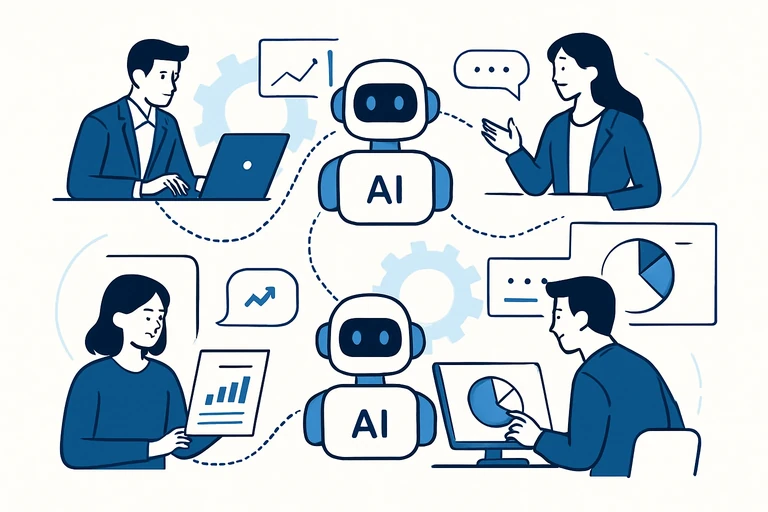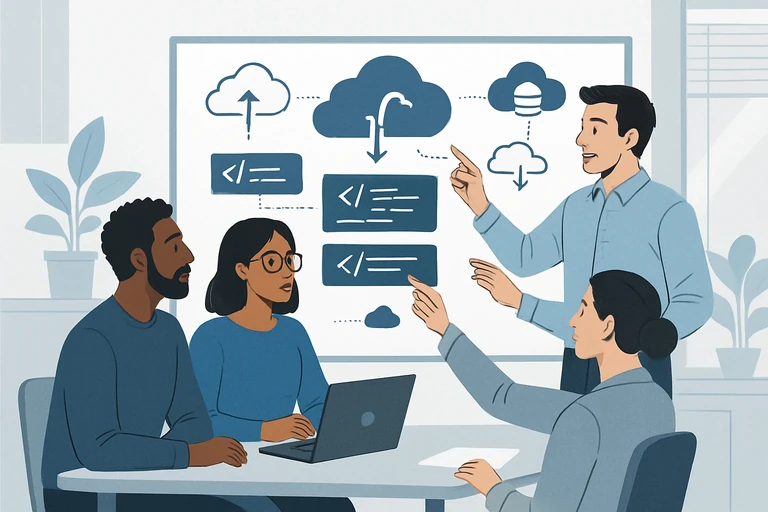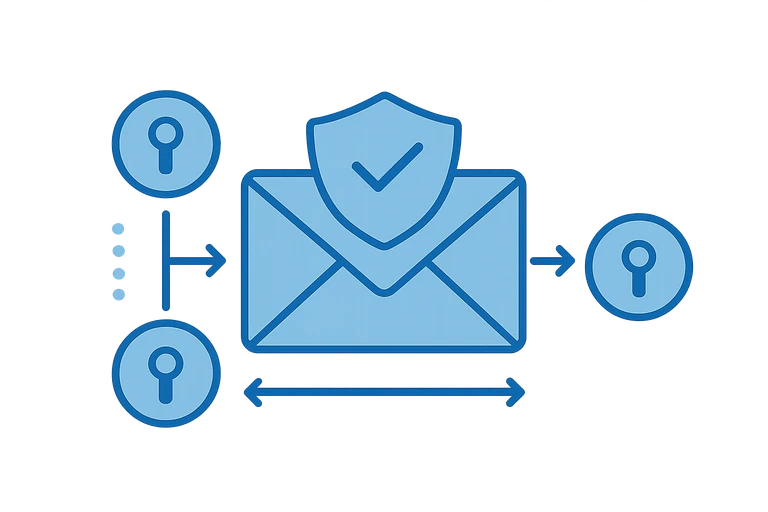The Rise of Autonomous Agents in 2025 explores practical patterns, platforms, and governance conside...

Best Practices for Building Scalable SaaS Architectures in 2025
A practical, step-by-step guide to designing cloud-native SaaS architectures that scale in 2025, covering data isolation, API-first design, observability, security, AI integration, and FinOps.
Best Practices for Building Scalable SaaS Architectures in 2025
Designing a Software-as-a-Service (SaaS) platform that is scalable, secure, and cost-efficient requires a holistic approach. In 2025, the most successful SaaS architectures balance multi-tenancy, cloud-native patterns, robust observability, data privacy, and the ability to innovate rapidly—with AI-driven capabilities where appropriate. This guide presents practical, field-tested practices that you can apply today to build architectures that scale with your customer base and evolving business needs.
1. Core architectural principles for 2025
To support rapid onboarding, predictable performance, and durable cost control, start with a platform mindset:
- Cloud-native, modular design. Build small, independently deployable services (microservices or serverless components) that can scale horizontally and be updated without affecting the entire system.
- API-first approach. Expose stable, versioned APIs (REST or GraphQL) that enable easy integration and long-term backward compatibility.
- Multi-tenant data separation. Choose a tenant isolation model that matches your risk profile, data needs, and growth trajectory (see data isolation patterns below).
- Observability by default. Instrument everything (metrics, logs, traces) from day one to reduce MTTR and improve capacity planning.
- Security by design (Zero Trust). Never trust by default; validate every request and enforce least privilege at every layer.
- Cost discipline (FinOps). Continuously measure usage by tenant, optimize resource allocation, and align pricing with actual consumption.
These principles echo guidance from major cloud providers and industry best practices. For example, the AWS Well-Architected Framework emphasizes the pillars of security, reliability, performance efficiency, cost optimization, and sustainability, which map directly to SaaS architectural decisions.
2. Data architecture for multi-tenant SaaS
Data is the lifeblood of a SaaS platform. How you isolate, secure, and access tenant data determines both security posture and performance under load. In 2025, common approaches include schema-based isolation, database-per-tenant isolation, or a shared-driends model with strong tenant context. Each model has trade-offs in complexity, cost, and scalability.
Tenant isolation models are a core design decision. Schema-based isolation uses a shared database with tenant-specific schemas or row-level security; database-per-tenant isolation gives each tenant a separate database; a hybrid approach can mix these by data domain. When evaluating options, consider regulatory requirements, data residency, and operational complexity. Cloud-provider guidance highlights the importance of deliberate data isolation to reduce the attack surface and simplify governance. For example, Azure’s multitenant guidance emphasizes tenant isolation, automated onboarding, and governance as key design patterns.
Beyond isolation, plan for data residency and lifecycle management. Global SaaS offerings often need to meet regional data residency requirements while still providing a unified product experience. Architecture patterns such as compartmentalization (e.g., per-tenant data segregation) support both security and compliant data management. See Google Cloud’s discussions of compartmentalized SaaS architectures for practical examples.
Operational tips for data design:
- Store tenant identifiers with every row and enforce tenant-aware queries at the API layer. This helps prevent cross-tenant data leakage and supports accurate billing and analytics.
- Choose a scalable database strategy aligned with your workload: distributed relational databases (e.g., cloud-native options) with read replicas, or horizontally sharded architectures for very large datasets.
- Implement tenant-aware indexes and query routing to avoid cross-tenant scans that degrade performance.
- Consider encryption at rest and in transit with tenant-specific controls where needed, and use robust key management to support data privacy requirements.
3. API-first design and integration readiness
Modern SaaS products operate in a connected world. An API-first strategy enables rapid integration with customer systems, third-party services, and internal tooling. Best practices include:
- Versioned APIs with clear deprecation paths to protect customer integrations.
- OpenAPI/Swagger for API contracts, plus comprehensive Postman collections for developers.
- Secure API access via OAuth 2.0 / JWT, with rate limiting and per-tenant quotas to prevent abuse and protect service quality.
- API gateways for central policy enforcement, telemetry, and routing to the appropriate service.
- Event-driven patterns and webhooks to enable real-time integrations and reduce polling overhead.
Azure’s multitenant deployment and configuration guidance highlights the importance of automation, IaC, and automated onboarding for consistent, scalable deployments across tenants. Automating provisioning, configuration, and updates reduces manual error and accelerates time-to-value for customers.
4. Observability, monitoring, and tracing
Observability is non-negotiable in 2025. A robust observability stack enables you to detect, diagnose, and fix issues quickly, while also providing insights for capacity planning and cost optimization. A mature stack typically includes:
- Metrics (infrastructure, APM, and business KPIs) to monitor service health and SLA adherence.
- Logs that are structured, centralized, and correlated with tenant context.
- Distributed tracing to follow requests across microservices and identify cross-service bottlenecks.
- Telemetry standardization- OpenTelemetry (OTEL) has matured into a de facto standard in 2025, enabling vendor-agnostic instrumentation and easier tool-switching.
Why OTEL matters: using a single instrumentation approach lets you collect traces, metrics, and logs once and publish to multiple backends, simplifying migrations and tool evaluations. This is particularly valuable for SaaS platforms that need to support multiple customers with diverse telemetry preferences.
5. Deployment, automation, and platform practices
Continuous delivery, infrastructure as code, and platform thinking are essential for SaaS scale. Practical steps include:
- Infrastructure as Code (IaC). Use Terraform, Pulumi, or cloud-native tools to provision and manage infrastructure consistently across tenants and regions.
- CI/CD and GitOps. Automate builds, tests, and deployments; use blue/green or canary strategies to reduce risk with new releases.
- Automated tenant onboarding. Provide self-service onboarding with policy-driven provisioning, ensuring every new tenant starts from a known-good baseline.
- Feature flags and progressive delivery. Roll out new capabilities gradually to subsets of tenants to manage risk and feedback loops.
Azure’s guidance on multitenant deployment emphasizes automation, deployment pipelines, and IaC as key patterns to scale enrollment and maintenance across tenants.
6. Security, privacy, and compliance by design
Security is foundational in SaaS. A modern architecture adopts a Zero Trust posture, least privilege access, and tenant-aware security controls across the stack. Key considerations include:
- Tenant isolation. Ensure logical and, where needed, physical separation to protect tenant data and workloads.
- Identity and access management (IAM). Centralized identity with tenant-scoped permissions, federated identities, and MFA for privileged roles.
- Data encryption. Encrypt data at rest and in transit; manage keys with a centralized, auditable process.
- Auditability and governance. Maintain immutable audit trails and enable customer access to logs and compliance reports as required.
- Regulatory alignment. Build to meet GDPR, CCPA/CPRA, HIPAA, SOC 2, ISO 27001, and other relevant standards, including data residency preferences per tenant.
Microsoft's Azure Architecture Center emphasizes architecture patterns that support deployment of secure, compliant multitenant SaaS, including automation, tenancy isolation, and controlled onboarding.
7. AI and ML: patterns for responsible AI in SaaS
AI and ML features (recommendations, automation, natural language interfaces) are increasingly embedded in SaaS products. A practical approach is to separate the AI inference and training workloads from core business logic, enabling independent scaling, auditing, and governance. Considerations include:
- Isolate AI components behind dedicated services or microservices to control latency, reliability, and cost.
- Apply MLOps practices to manage model lifecycle, data drift monitoring, and security/compliance for data used by models.
- Provide transparency and controls for customers when AI features impact data or decisions.
While AI trends evolve, keeping AI artifacts auditable and ensuring proper privacy controls remain essential design goals for 2025 SaaS architectures.
8. Performance, scalability, and edge considerations
To meet global customer demands, design for elasticity and low latency. Practical tactics include:
- Auto-scaling. Horizontal scaling of stateless services via Kubernetes HPA, serverless platforms, or cloud-native scaling policies.
- CDN and edge computing. Cache static content at the edge and run lightweight processing closer to users to reduce latency.
- Multi-layer caching. Client, edge, application, and database caches reduce hot-path latency and database load.
- Observability-driven optimization. Use real-user monitoring and synthetic tests to guide optimization and capacity planning.
9. Disaster recovery, reliability, and cost discipline
Resilience and cost control are core to SaaS viability. Implement:
- Disaster recovery (DR). Geographically distributed deployments, automated backups, and tested restore procedures with defined RTO/RPO.
- High availability. Cross-region replication, multi-AZ deployments, and automated failover.
- FinOps and cost optimization. Tag by tenant, monitor per-tenant usage, and optimize resource allocation to align cost with value delivered.
The AWS Well-Architected Framework formally codifies these practices under its pillars of Reliability, Security, and Cost Optimization, providing a structured lens to evaluate and improve your SaaS architecture.
10. A practical, step-by-step blueprint to start today
- Define your tenant isolation model (schema-based, database-per-tenant, or a hybrid) based on data sensitivity and scale goals.
- Design tenant-aware data access with a clear tenant ID, per-tenant authorization, and row-level security where appropriate.
- Adopt an API-first contract: set up OpenAPI specs, versioning, and a strategy for back-compatibility.
- Choose a cloud-native platform pattern: microservices or serverless functions with event-driven integration.
- Establish a robust observability stack (OTEL-based) across metrics, logs, and traces, and plan retention policies by tenant.
- Institute Zero Trust security, encryption, and comprehensive auditability from day one.
- Automate tenant onboarding, upgrades, and deprovisioning with IaC pipelines and automated validations.
- Build a scalable CI/CD pipeline with feature flags and canary deployments to minimize risk with updates.
- Incorporate AI thoughtfully: separate AI services, monitor data inputs, and ensure governance and user transparency.
- Plan DR, back-ups, and cross-region resilience; implement FinOps dashboards and per-tenant cost controls.
- Regularly review against a well-architected framework and adapt as your tenant base grows.
Conclusion
Building scalable SaaS architectures in 2025 requires a disciplined, platform-minded approach that combines robust data isolation, API-first design, strong security, and deep observability. By aligning with industry best practices—supported by cloud-provider guidelines and mature tooling—you can deliver a reliable, adaptable product that scales with your customers’ needs and your business goals. Embrace modularity, automate relentlessly, and measure everything across tenants to create a sustainable, competitive SaaS offering.


